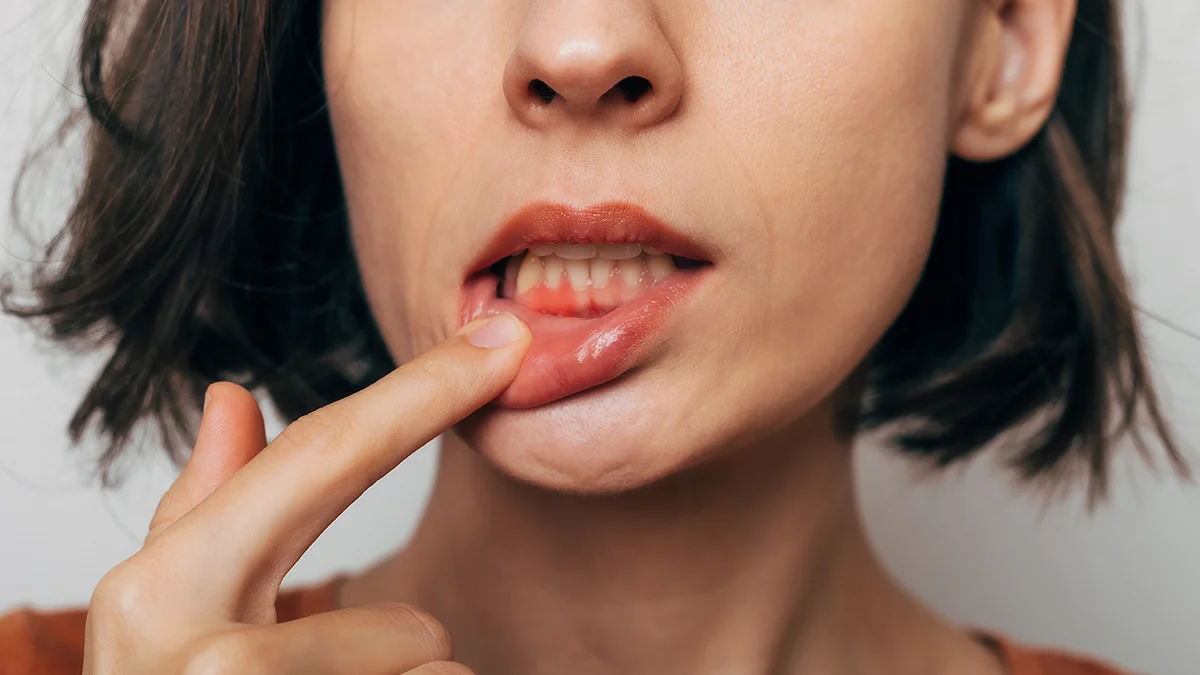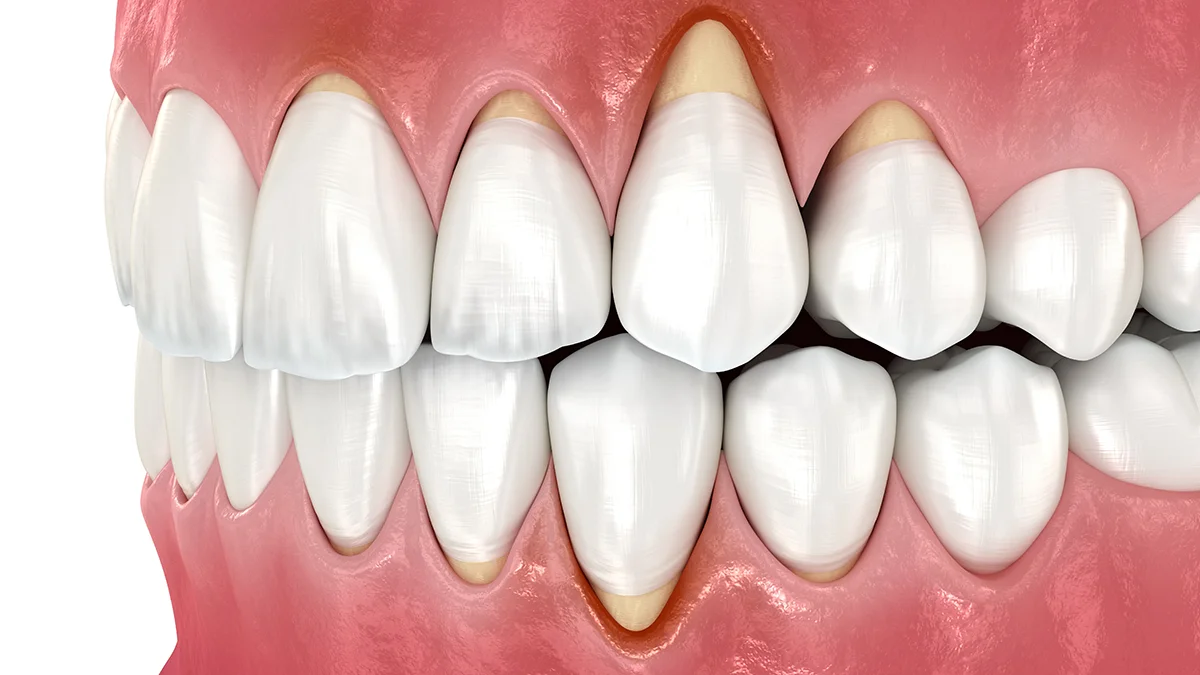12 min read
Understanding Gum Disease: How to Fix Gum Recession

Gum recession is not in your face obvious, but rather a silent, uneventful deterioration of oral health that affects millions worldwide. CDC says that 88% of adults over 65 have experienced some form of gum recession that often develops gradually and without pain. It is one of the easiest things to overlook until it advances, presenting with a mega dose of sensitivity and teeth that look strangely elongated, sometimes accompanied by an irritated and red receded gum line. It is not just an aesthetic problem, but a long-term threat that, left unaddressed, can increase the risk of tooth decay, a higher risk of gum infection, and eventually tooth loss. The latter will kick your self-esteem into the ground. This can happen very early in life, due to many factors, including untreated receding gums.
But a horror story, worse case scenario later, we ask - can receding gums grow back, and what steps can you take to protect your smile, now and in the future?
In this article, we’ll explore the change in oral health in the developed world, the role of gums in our oral cavity, causes of gum recession, how to manage and prevent it, and why the right toothbrush is everything, especially if you’ve already got some problems. So, before we protect your future, a little throwback to the cave past.
The short history of tooth and gum health
Doesn't it seem kind of counterintuitive to think of the developed parts of the world as those leading in gum disease and periodontal issues? After all, we have the advanced prevention, medical care, and all sorts of surgical and non-surgical interventions to protect our oral health. We have the fancy nitro to make us laugh at our decay and the sterile dentist’s clinics. Still, we spend so much time and money fighting off gingivitis, cavities, enamel damage, plaque, and gum recession while the tribesmen flash their perfect cavity-less pearly whites, sitting on a rock overlooking the savannah and chewing on a stick after a meal of slow-cooked harder chunks of meat and some ferments.
Our early hunter-gatherer ancestors never saw a toothbrush, didn’t know what fluoride was, and had a diet rich in meat and fibrous plants, essentially an involuntary keto diet regularly combined with fasting (because no hunter or forager was successful 100% of the time). They ate as much as they could when food was available, because no one knew where the next meal would come from, which created a balance between fasting and feasting. This keto-ish fasting pattern was broken only in the rare seasons of abundance, when the gatherers scored some honey, a tuber or two, or when sweet, ripe fruit was abundant before the weather turned cold (you needed to gain a few pounds before the winter to survive, and now we try to lose some before summer). In fact, anthropological evidence suggests a sudden increase in tooth and gum disease coinciding with the rise of organized agriculture and a corresponding population-wide rise in carbohydrate intake.

Our problems with tooth decay and periodontal disease are multifactorial, but hinge on some fundamental changes in lifestyle and diet. The developed parts of the world are usually those that refine their foods, making them convenient and easily available while providing a long shelf life. For food not to go off and be shelf-stable for months and years, you need to remove the fibre. Fiberless foods are soft, squishy, and offer no resistance when you chew; you need resistance and force for proper jaw development and teeth alignment, and you need fiber to feed the gut microbiome that runs your health.
Also, sugar is now lacing most of the processed food, whether you know it or not (due to the hundreds of names it's cleverly masked under), because the more palatable something is, the more you'll buy. You may have no problem eating a whole box of chocolates or drinking a liter of orange juice, but a few pieces of dark chocolate or a single orange will do. Traditional diets utilize unrefined, wholesome ingredients, such as those foraged from the wild or grown in undepleted soils, and animals that lived in their natural conditions and ate the food they were intended to consume. All of this contributes to overall better health (metabolic and otherwise), reflected as better oral health.
The role of gums in oral health
- Teeth Anchors: What happens if you pull out too much lipstick or a click eye pencil? The tip will break off from the forces because it is not anchored in place. Gums are soft but sturdy tissue that overlays the bones in your mouth and the crowns of your teeth, effectively securing your teeth in place.
- Signs of Health: A good old-school GP doctor who believed in holistic health would have looked at your teeth and gums as a part of your general health check. Healthy gums are typically pink and firm, and should not bleed during regular brushing or flossing.
- Illness signaling: Symptoms such as bleeding, swelling, or discoloration may be warning signs of underlying conditions, including heart disease or diabetes. So pay attention to any changes.
- Protective Function: A regular gum line acts as a shield for our teeth, providing a tight fit that guards against bacteria and food particles entering underneath and reaching the sensitive tooth roots.
- Uniquely Yours: Outside of he basic rules governing the human body, our bodies exhibit differences in affinities, subtleties, functioning, strengths, sensitivities, and shapes. Just like our teeth (which is why identification is possible through dental records), the gums are distinct to each person, exhibiting variations in color, shape, and texture.
What is gum recession, and what are the risk factors?
A super simple explanation is that gum recession is when the gum tissue surrounding your teeth pulls back or wears away. You’ll notice more tooth exposure than before and may feel like your teeth appear elongated. They are not; you can just see the parts that were supposed to remain covered and protected by the gums. This exposed area is the danger zone, more sensitive and more prone to plaque buildup and decay.

Why do we get gum recession?
- Brushing too hard or using an electric or disposable toothbrush with hard bristles can irritate, damage, and wear away the gums.
- Inadequate oral hygiene leads to plaque buildup that pushes the gums further up and introduces bacteria where they were never supposed to be.
- Periodontal (gum) disease may have a genetic component, but it also depends on lifestyle choices.
- Tobacco use, smoking, or chewing is a really bad idea for oral health in general
- Hormonal swings such as those in puberty, pregnancy, or menopause
- Clenching or grinding your teeth, sometimes while awake or while you sleep (bruxism)
- Natural aging and the slowing down of bodily processes that repair daily damage.
If you get a cut in your skin or trim your hair, this will all regenerate quite quickly. Unlike skin or hair, gum tissue is not easily or quickly regenerable. That’s why regular visits to your dentist are for more than just catching cavities. They are designed for the early detection and prevention of periodontal diseases, such as gum recession or enamel damage, protecting what you have for as long as possible.
Brush, brush, brushing your gums away
When you brush your teeth, this is the only time you clean your skeleton. Everyone and their grandma thinks that if you brush with a force of a thousand suns, you’ll get cleaner teeth. This is not true. If you had a completely wet shirt, it couldn’t get any wetter, regardless of how much more water you add. If the surface of the tooth is clean, dedicated overzealous brushing won’t make it cleaner, but might damage the gums. This is why we should also teach our children proper brushing habits from the start. Gums are tissues far softer than the bone they protect and can be eroded over time, especially with hard-bristled toothbrushes.
How to know if you’re brushing your teeth too hard? If your gums bleed when brushing or appear to be pulling away from your teeth, ever so slightly or fairly visibly, it's time to take a look at your technique and your toothbrush.

Choose a gum-friendly toothbrush
Things we do daily seem too mundane to think about and reconsider. We’re busy people with a lot to think about and do, far above in the grand scheme of things. But this is backwards. The things we do every day are the ones that become habits, shape our lives, and seal our fates. This is not being overly dramatic. It’s just following the logic. Choosing the wrong toothbrush (which you ideally use at least twice a day) may compromise aspects of your oral health, such as the natural protective function of the gums.
Over time, the damage accumulates, and you begin to lose teeth, or the bacteria that were allowed to reach the root, unprotected by the gum tissue, start to destroy the root that sits in the jawbone. A rotten tooth can have systemic effects and contribute to various disease states, including heart disease, inflammation, sepsis, hypertension, and bacterial meningitis. So, yes, daily choices do matter. When choosing your next toothbrush (especially if you’ve noticed some gum recession or have been warned by your dentist) pay attention to these points:
Bristle softness
Sure, you might feel firm bristles get the job done faster and better. They do clean, but also cause some damage to anything softer than bone. Soft bristles clean effectively without scraping or irritating the delicate gumline. Unlike firmer bristles that can wear down tissue, the soft ones flex and respect the contours of teeth and gums, lifting plaque without irritation.
Sonic technology
Sonic toothbrushes are a new breed of toothbrush that doesn’t rely on mechanical scraping, but uses high-frequency vibrations to dislodge plaque without the need for extensive force. These vibrations are so fast that they can not only help clean the visible surfaces of your teeth but also along and just below the gumline. Less manual pressure means a lower risk of unintentional gum damage.
MYSA team recommends: The new clinically proven issa™ 4 collection of silicone sonic toothbrushes:
🗸 Clinically proven to improve overall oral hygiene by 140%.*
🗸 Clinically proven to remove 30% more plaque than your regular manual toothbrush.*
🗸 Clinically proven to reduce gingivitis & 100% of testers report whiter teeth.*
🗸 3 new modes - deep clean, whitening, sensitive.
* Based on results from 3rd-party clinical testing, in a 4-week trial with twice-daily use.

Built-in Pressure Sensors
We, the overbrushers, are mostly not aware of how hard we’re pressing. The wonderful advances in technology have allowed many high-end modern toothbrushes to come equipped with pressure sensors, letting you know when you’re pressing too hard. This feature gently guides toward a softer, safer brushing technique that will not cause repeated trauma to the gums.
Gum-Care Modes
Circulation is what it's all about, and all body cells love to get more oxygen and nutrient-rich blood. A very good sonic toothbrush will have an option of special brushing modes designed explicitly for gum care. These deliver soothing pulsations that massage the gumline to boost the blood flow and may support tissue resilience in areas prone to sensitivity or inflammation.
The things we do every day add up to lasting health and are far more important in the long run than those we do once or twice a year.
How to protect your gums and prevent further recession
Gum recession can be a result of our actions or inaction, but it can also occur even when we do everything right. Either way, if you notice signs of gum recession, you are not helpless. Gingival recession self-care offers several simple oral care and life habits you can adopt to protect your gums:
- Choose a soft-bristled electric toothbrush, preferably a silicone sonic toothbrush with pressure sensors or gentle cleaning modes. It would be a good idea to avoid aggressively rotating electric toothbrushes.
- Brush gently along the gumline, and avoid the urge to aggressively scrub; let your gums recover.
- Gently floss every day to remove plaque from between your teeth rather than trying to force the bristles into the interdental (between the teeth) spaces.
- Consider using mouth rinses with anti-inflammatory ingredients, or even just some salt water or coconut oil to swish around your mouth. These will control the bacterial growth, but will not kill the good bacteria you need. Avoid harsh alcohol and chemical-laden mouth washes, as they have been connected to an increase in hypertension and heart disease due to killing off the beneficial microbiome.
- Avoid smoking and manage stress. We know that stress management advice seems like a broken record and is most likely causing you some additional stress, but we’re not talking about Ace Ventura astral projection peace in the ashram. Some level of stress is necessary in certain moments; it prepares your body to perform better. After you have done what was needed, rest and relax to return to your baseline. Stress is not the problem; chronic stress is.
- Visit your dentist regularly to monitor your gums and provide professional care. No one is a fan of that horrid chair, but take it like a bit of temporary stress for much better outcomes later.
Natural treatment for receding gums at home
In addition to all we’ve mentioned for gingival recession self-care, there are some additional ways to fix receding gums at home. Some we’ve already mentioned, and are so clean and natural that it’s worth pointing them out again, some you may have never heard of. These are some of the simplest and most successful natural methods to try. Seriously, they are so benign that you can freely swallow the ingredients, and they will likely do further good for the body.
- Salt is a magnificent gift from nature. Saltwater rinses can help calm irritated gums and gently cleanse the mouth, with zero side effects.
- Oil pulling with coconut or sesame oil may reduce bacteria and plaque.
- Aloe vera gel is known for its soothing and healing properties, which may help calm inflammation.
- Turmeric contains natural anti-inflammatory compounds that can support gum comfort.
- Vitamins like C and collagen supplements help strengthen gum tissue from within.
While these natural gum disease medications offer supportive benefits, they may not be enough on their own and will not keep you from the dentist’s chair forever. They are most effective when used in conjunction with good daily oral hygiene and professional guidance. I’m sorry, that dentist is a must, no matter how many gallons of salt water pass your lips.
Professional care for advanced gum recession
When gum recession progresses past a certain point, natural treatments and minimal interventions are no longer enough. Here we use dental treatments that can help restore gum health and prevent further damage:
Non-surgical care, such as scaling and root planing, removes plaque beneath the gumline and helps gums reattach. Topical antibiotics may be used to control the risk of infection.
Surgical options include gum grafts, which add new tissue to exposed roots. A minimally invasive pinhole surgery repositions existing tissue, and regenerative procedures are applied that encourage new tissue and bone growth.
Whatever the treatment from a bit more radical side, we still fall back on the ultimate truth - that grafts and grand feats of modern stomatology mean nothing if we ignore daily oral care.
Can Receding Gums Grow Back?
Now, here we have a difference of irritation and massive damage. In the early stages of mild to moderate gum recession, inflammation can be reduced and tissue health significantly improved through gentle brushing, good hygiene, and professional care, allowing you to regain some of your gumline.

However, once gum tissue has receded significantly, it does not naturally regenerate on its own. Nevertheless, even in more advanced cases, there are treatments to restore gum coverage and prevent further loss. You’re not doomed to a long-toothed, inflamed existence on the verge of toothlessness. That is why we are so adamant about not missing dentist visits. We want to catch any changes as early as possible.
Conclusion
Gums are a versatile and potent protection of the tooth root, and gum recession isn’t just a matter of a few millimeters of tissue loss. It is a loss of confidence and an unnecessary risk for tooth decay and periodontal disease. On the positive note, gum recession detected early is also a signal, a nudge from your body asking for gentler care, better lifestyle, more awareness, and a return to the basics.
While there are cases of extensive damage that may require surgical intervention to repair, much of the early damage can still be prevented by reconsidering your habits, toothbrush, and technique as quiet rituals with a significant impact on oral health outcomes. And that’s good news — because it means the (hopefully sonic and silicone) power to protect your teeth and your confidence lies where it always has: in your hands, twice a day, every day. Stay beautiful, stay curious, and find a reason to smile today.








Comments
2 comments
Leave a comment